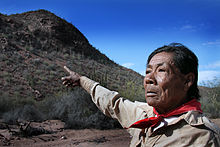You can help expand this article with text translated from the corresponding article in Spanish. (March 2009) Click [show] for important translation instructions.
|
This article needs additional citations for verification. (September 2022) |
Comcaac | |
|---|---|
 | |
 Chapito, a Seri shaman from Punta Chueca, Sonora | |
| Total population | |
| ~1,000 (2006)[1] | |
| Regions with significant populations | |
Sonora | |
| Languages | |
| Seri • Spanish | |
| Religion | |
| Traditionally animists, currently primarily Christian |
The Seri or Comcaac people are an Indigenous group of the Mexican state of Sonora. The majority reside on the Seri communal property (Spanish: ejido), in the towns of Punta Chueca (Seri: Socaaix) and El Desemboque (Seri: Haxöl Iihom) on the mainland coast of the Gulf of California. Tiburón Island (Tahejöc) and San Esteban Island (Cofteecöl and sometimes Hast) were also part of their traditional territory. They maintain an intimate relationship with both the sea and the land. They are one of the ethnic groups of Mexico that has most strongly maintained their language and culture throughout the years after contact with Spanish and Mexican cultures.
The Seri people are not related culturally or linguistically to other groups that have lived in the area, such as the Opata, Yaqui (sg.: Yequim, pl.: Yectz), O'odham (sg.: Hapaay), or Cochimí. The Seri language is distinct from all others in the region and is considered a language isolate.[2]
Beside the Apache (sg.: Hapats, pl.: Hapatsoj) and Yaqui, the Seri are best known as fierce warriors for their resistance against subjugation by the Spanish (sg.: Casopin) and later Mexicans (sg./pl.: Cocsar). The Seri had been living on the coast of Sonora with little outside interference for centuries, if not millennia.[3] But with colonization, they were displaced from their land and forced to work for others and adopt Christianity. Resendez writes about a slaving raid in 1660s: "A posse of Spaniards had cut a swath through the Seri lands, killing most of the adults of one band and distributing the children in the Spanish towns of Sonora."[3]
The name Seri is an exonym of uncertain origin. (Claims that it is from Opata or from Yaqui were nineteenth-century speculations based on similarity to words in those languages and lack clear evidence.)[2] Their name for themselves is Comcaac (phonemically /kom'kɑːk/, phonetically [koŋˈkɑːk]); singular: Cmiique (phonemically /'kmiːkɛ/), phonetically [ˈkw̃ĩːkːɛ]).[4]
- ^ Martlett, Stephen (2006). The Sociolinguistic Situation of the Seri Language in 2006 (PDF). SIL International. Archived from the original (PDF) on 25 Feb 2024.
- ^ a b Marlett, Stephen (2011-01-01). "The Seris and the Comcaac: Sifting fact from fiction about the names and relationships". Work Papers of the Summer Institute of Linguistics, University of North Dakota Session. 51 (1). doi:10.31356/silwp.vol51.01. ISSN 0361-4700.
- ^ a b Resendez, Andres (2016). The Other Slavery: The Uncovered Story of Indian Enslavement in America. Houghton Mifflin Harcourt. p. 177. ISBN 978-0544602670.
- ^ Marlett, Stephen A.; Herrera, F. Xavier Moreno; Astorga, Genaro G. Herrera (2005). "Seri". Journal of the International Phonetic Association. 35 (1): 117–121. ISSN 0025-1003.